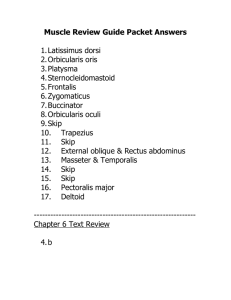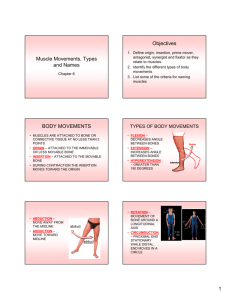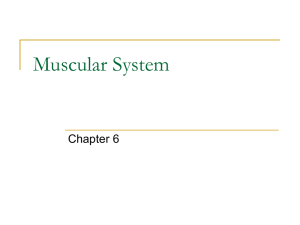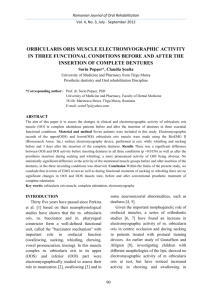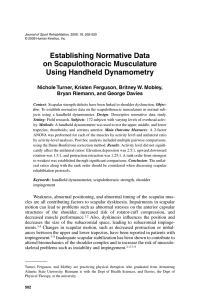Muscle Review Packet Answer Key
advertisement
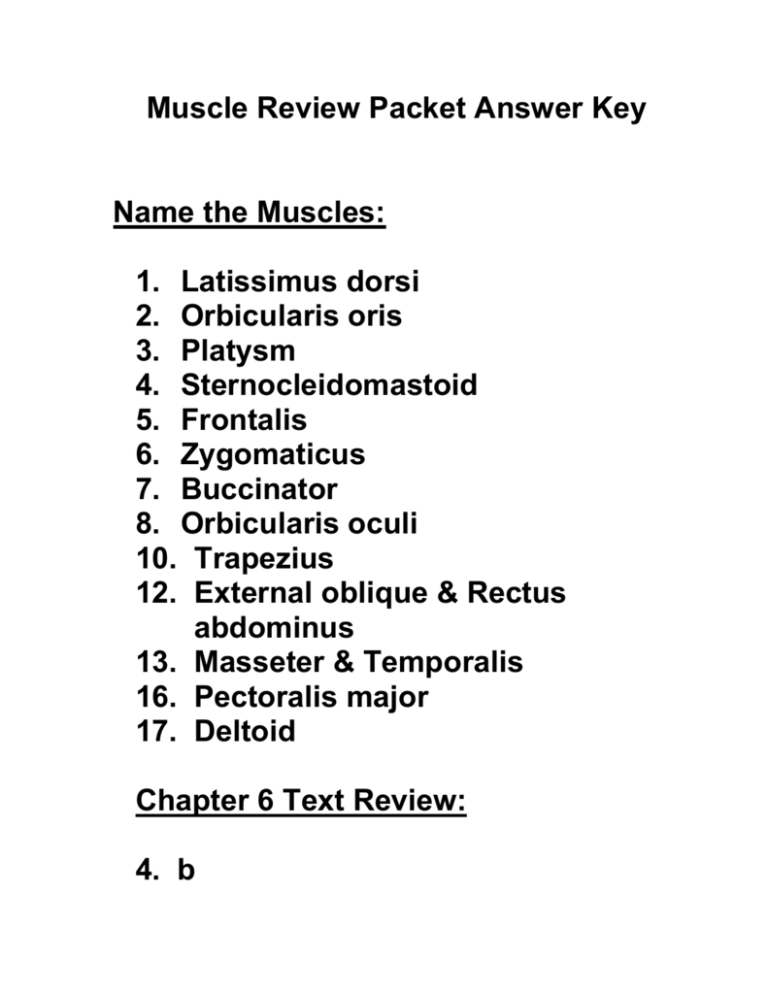
Muscle Review Packet Answer Key Name the Muscles: 1. Latissimus dorsi 2. Orbicularis oris 3. Platysm 4. Sternocleidomastoid 5. Frontalis 6. Zygomaticus 7. Buccinator 8. Orbicularis oculi 10. Trapezius 12. External oblique & Rectus abdominus 13. Masseter & Temporalis 16. Pectoralis major 17. Deltoid Chapter 6 Text Review: 4. b 10. Origin – immovable end Insertion – moveable end; during contraction, the insertion moves toward the origin 12. Prime mover – muscle that has major responsibility for causing a particular movement ex: biceps – arm flexion Synergist – aids prime mover by causing same movement (less effectively) or by stabilizing joints or bones on which the prime mover acts ex: temporalis – aids masseter *Prime mover may be an antagonist also ex: biceps – antagonist to triceps (arm extension) 13. Masseter (prime mover for chewing) frontalis – forehead - move eyebrows buccinators – cheek – whistle orbicularis oris – lips – kiss 14. Trapezius (extends neck) 15. Pectoralis major & Latissimus dorsi 16. Prime mover – biceps Antagonist – triceps 17. The 4 muscle pairs are arranged so that their fibers run in different directions, much as sheets of wood grains are compressed together to make plywood – extremely strong for its thickness 3. Any muscle that inserts on the clavicle – trapezius 6. Abnormal lateral curvature of the spine = scoliosis – caused by unequal muscle pull on the spine 5. The pesticide is a chemical that inhibits the enzyme that breaks down acetylcholine. Acetylcholine remains in the synapse & stimulates skeletal muscle activity Vocab: 1. e 2. h 3. frontalis (j) – epicranial muscles 4. i 5. skip (g) 6. b 7. a 8. c 9. k 10. f Multiple Choice - Part A 1. c 2. a 3. b 4. c 5. a 6. c 7. c 8. d 9. b 10. c Fill in the Blank - Part B 1. origin 2. deltoid 3. contraction 4. belly (body) 5. circumduction Muscle Recognition Review 1. t 2. v 3. y 4. u 5. g 6. e 7. q 8. w 9. c 10. r 11. b 12. d 13. a 14. s 15. f 16. h 1. 2. 3. 4. 5. k j i a l Review Guide: 1. Buccinator 2. Zygomaticus 3. Orbicularis oculi 4. Platysma 5. Frontalis 6. Orbicularis oris 7. Masseter 8. External oblique 9. Rectus abdominus 10. Sternocleidomastoid 11. Deltoid 12. Pectoralis major 13. Trapezius 14. Latissimus dorsi 15. Temporalis 16. directly to the periosteum by tendons (cords of connective tissue) by an aponeurosis (sheet of connective tissue) 17. flexion – bending the elbow extension – standing up (legs) abduction – moving leg out to side of body adduction – moving arm toward midline of body rotation – turning head from side to side circumduction – pitching a baseball 18. The skeletal muscle pull on the insertion (distal attachment) causing the bone/limb to move toward the origin (proximal attachment) *the muscle moves the body part it inserts into* 19. Muscles work in groups 20. Superficial muscles are closest to the body surface & provide contours (shape) Deep muscles are beneath the superficial muscles, closest to the internal organs 21. Action - adductors Direction of fibers – obliques (diagonal) Location – frontalis over frontal bone Shape – deltoid triangular Size – gluteus maximus large # of attachments – biceps 2 origins points of attachment – sternocleidomastoid (sternum, clavicle, mastoid process) 22. True 23. Flexion of the wrist (radial side) 24. In humans, each muscle is one large muscle but in cats they are separated into 3 distinct muscles 25. Facial muscles may insert into other muscles or connective tissues rather than just over bones KNOW THE HUMAN & CAT DIAGRAMS ~ half the quiz
